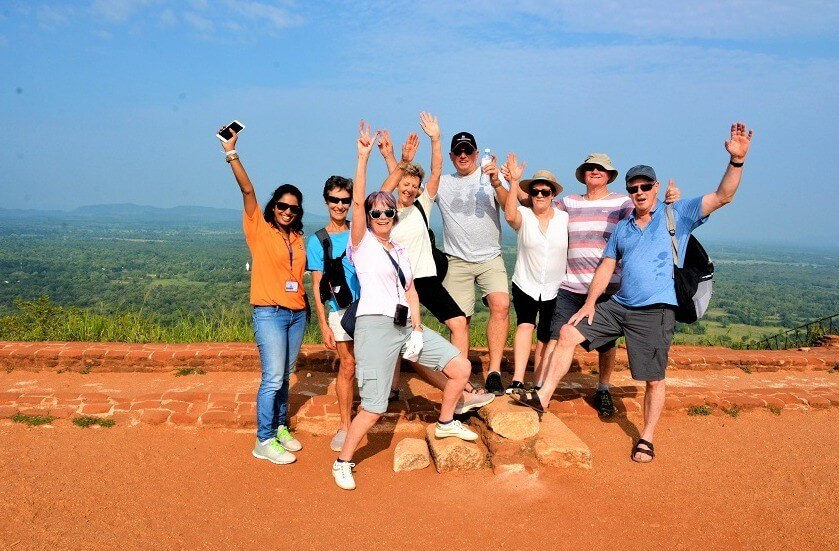Small group tours for seniors offer a unique blend of adventure and comfort, catering to the specific needs and preferences of older travelers. These tours prioritize accessibility, safety, and social interaction, ensuring a memorable and enriching experience. From meticulously planned itineraries to comfortable transportation and carefully selected accommodations, every detail is considered to create a seamless and enjoyable journey for senior adventurers. This guide delves into the essential aspects of planning and executing successful small group tours designed specifically for the senior demographic, covering everything from destination selection to health and safety protocols.
We will explore ideal destinations, suitable activities, and logistical considerations, including transportation, accommodation, and group dynamics. Furthermore, we’ll address crucial health and safety concerns, offering practical strategies for mitigating risks and ensuring a worry-free travel experience. Finally, effective marketing strategies to attract this specific target audience will be discussed.
Tour Destinations for Seniors
Choosing the right destination for a senior travel group requires careful consideration of accessibility, climate, and activities. We’ve compiled a list of popular international locations that offer a balance of cultural richness and ease of navigation for older travelers. The focus is on destinations that minimize physical strain and maximize enjoyment.
Popular and Accessible International Destinations for Senior Tours
Below is a table outlining ten international destinations well-suited for small group senior tours. Each location offers a unique blend of attractions and accessibility features. The potential activities listed are suggestions and can be adapted to the group’s specific interests and physical capabilities.
| Destination | Country | Accessibility Features | Potential Activities |
|---|---|---|---|
| Kyoto | Japan | Relatively flat terrain in many areas, good public transportation (including accessible trains and buses), many temples and gardens with accessible paths. | Visiting temples and gardens, tea ceremonies, traditional crafts workshops, exploring Gion district, serene boat rides. |
| Amsterdam | Netherlands | Excellent public transportation (trams, buses, and accessible canal boats), mostly flat terrain, many accessible museums and attractions. | Canal cruises, exploring museums (Rijksmuseum, Anne Frank House), cycling tours (e-bikes available), visiting flower markets. |
| San Sebastian | Spain | Relatively flat city center, good public transportation, many accessible restaurants and shops. | Exploring the Old Town, enjoying pintxos (Basque tapas), relaxing on La Concha beach, scenic walks along the bay. |
| Quebec City | Canada | Many accessible attractions, good public transportation, cobblestone streets in some areas (potentially challenging for some). | Exploring Old Quebec, visiting the Citadelle, enjoying French-Canadian cuisine, taking a horse-drawn carriage ride. |
| Florence | Italy | Many accessible museums and churches (though some may have steps), good public transportation, relatively flat areas in the city center. | Visiting the Uffizi Gallery, exploring the Duomo, enjoying gelato, walking along the Arno River. |
| Lisbon | Portugal | Many accessible attractions, good public transportation (including trams and funiculars), some hilly areas (consider using taxis or trams for steeper inclines). | Exploring Alfama district, riding the iconic trams, visiting Jerónimos Monastery, enjoying Fado music. |
| Vienna | Austria | Excellent public transportation, many accessible museums and palaces, relatively flat city center. | Visiting Schönbrunn Palace, exploring the Hofburg Palace, attending a classical music concert, enjoying Viennese coffee house culture. |
| Charleston | USA | Many accessible attractions, good public transportation, relatively flat areas in the historic district. | Exploring historic streets, visiting plantations, enjoying Southern cuisine, taking a horse-drawn carriage ride. |
| Sydney | Australia | Good public transportation, many accessible attractions, though some areas may require more effort (consider accessibility features when booking tours). | Visiting the Sydney Opera House, exploring the Royal Botanic Garden, enjoying harbor cruises, visiting Bondi Beach. |
| Budapest | Hungary | Good public transportation, many accessible attractions, some hilly areas (consider using public transport or taxis for steeper inclines). | Visiting Buda Castle, exploring the thermal baths, enjoying a Danube River cruise, exploring the Jewish Quarter. |
Seven-Day Kyoto Itinerary: A Senior-Friendly Approach
This itinerary focuses on Kyoto, Japan, highlighting aspects beneficial for senior travelers. Pace and activities can be adjusted based on the group’s preferences and physical capabilities.
Day 1: Arrival and Relaxation – Settle into your hotel, enjoy a traditional Japanese dinner.
Day 2: Eastern Kyoto – Visit Kiyomizu-dera Temple (accessible paths available), stroll through Gion district (relatively flat).
Day 3: Arashiyama Bamboo Grove – Explore the serene bamboo grove (accessible paths), enjoy a boat ride on the Hozugawa River (consider alternatives if mobility is limited).
Day 4: Golden Pavilion – Visit Kinkaku-ji (relatively flat approach), enjoy a traditional tea ceremony.
Day 5: Fushimi Inari Shrine – Explore the thousands of vermillion torii gates (partially accessible, some inclines). Consider using a taxi or bus to minimize walking.
Day 6: Nishiki Market and Relaxation – Explore Nishiki Market (mostly flat), enjoy a relaxing afternoon at your hotel or a local onsen (hot spring).
Day 7: Departure – Enjoy a final Japanese breakfast before departing from Kyoto.
Tour Activities and Itineraries
Creating enjoyable and accessible itineraries is paramount for senior small group tours. We aim to provide a balanced program catering to diverse interests and mobility levels, ensuring everyone has a memorable and comfortable experience. Our itineraries are designed with ample time for relaxation and personal reflection alongside engaging activities.
Diverse Activity Options for Seniors
We offer a range of activities to suit different preferences and physical capabilities. These activities are carefully selected to minimize strenuous exertion while maximizing engagement and enjoyment.
- Gentle Walking Tour of Historical Sites: A leisurely paced tour focusing on historical landmarks and points of interest, allowing for frequent rest stops. This activity is suitable for most mobility levels, with options for shorter routes or alternative transportation if needed.
- Interactive Museum Visit: Visiting museums with accessible facilities and engaging exhibits, incorporating interactive elements and comfortable seating areas for breaks. This caters to a broad range of interests and mobility levels.
- Scenic Boat Cruise or Train Ride: Enjoy breathtaking views with minimal physical exertion. These activities offer a relaxing way to appreciate the surroundings, suitable for those with limited mobility.
- Cooking Class Focused on Local Cuisine: A hands-on, seated cooking class focusing on preparing regional specialties. This activity is engaging, social, and requires minimal physical effort.
- Guided Nature Walk with Rest Stops: A gentle walk through nature trails with frequent rest stops and opportunities to appreciate the flora and fauna. This option can be adapted to suit various mobility levels by adjusting the length and difficulty of the trails.
Comparison of Activity Pacing and Physical Demands
The activities are designed with varying pacing and physical demands to cater to diverse needs. Gentle walking tours and nature walks involve moderate physical activity, while museum visits, boat cruises, and cooking classes are largely sedentary. Itineraries incorporate a mix of these activities, ensuring a balanced program. For example, a day might begin with a gentle walking tour followed by a relaxing boat cruise and conclude with a more sedentary museum visit. We always prioritize comfort and flexibility.
Sample Daily Itinerary
This itinerary exemplifies a balanced approach to activity selection and incorporates flexibility and rest periods.
| Time | Activity | Notes |
|---|---|---|
| 9:00 AM | Gentle Walking Tour of Old Town | Pace adjusted to group’s needs; frequent rest stops. |
| 11:00 AM | Coffee Break at a Local Cafe | Relaxation and social interaction. |
| 11:30 AM | Visit to a Local History Museum | Accessible facilities; interactive exhibits. |
| 1:00 PM | Lunch at a Restaurant with Scenic Views | Time for relaxation and social interaction. |
| 2:30 PM | Scenic Boat Cruise on the River | Relaxing activity with minimal physical exertion. |
| 4:00 PM | Free Time/Relaxation at the Hotel | Opportunity for rest or individual activities. |
| 6:00 PM | Dinner at the Hotel or a Local Restaurant | Social interaction and enjoyment of local cuisine. |
Group Dynamics and Social Aspects
Creating a positive and inclusive group dynamic is crucial for a successful senior travel experience. A well-managed group fosters a sense of community, encouraging participation and making the journey more enjoyable for everyone. Addressing potential conflicts proactively and providing ample opportunities for social interaction are key elements in achieving this.
A strong group dynamic relies on careful planning and facilitation. It’s about building rapport and understanding amongst participants, allowing for individual needs and preferences while cultivating a shared sense of purpose and adventure.
Fostering Positive and Inclusive Group Dynamics
Establishing a welcoming and inclusive atmosphere begins before the tour even starts. Pre-trip communication, such as a welcome email introducing fellow travelers and outlining the trip’s schedule, can help build anticipation and a sense of camaraderie. During the trip, the tour leader should actively encourage interaction and participation from all members. This could involve informal icebreaker activities at the beginning of the tour, such as sharing personal travel anecdotes or favorite hobbies. The tour leader should also be mindful of individual needs and preferences, adapting activities to accommodate varying levels of mobility or interests. For instance, offering optional activities allows individuals to choose experiences that align with their capabilities and preferences, preventing anyone from feeling excluded or pressured. This proactive approach helps prevent isolation and promotes a sense of belonging for all participants.
Managing Potential Conflicts or Disagreements
While disagreements are inevitable in any group setting, proactive strategies can minimize their impact. The tour leader should establish clear communication guidelines from the start, emphasizing respectful dialogue and active listening. Mediation techniques, such as encouraging participants to express their perspectives calmly and empathetically, are crucial in resolving conflicts. If a conflict escalates beyond the tour leader’s ability to manage, having a pre-determined plan for contacting support services or emergency contacts is essential. For example, a designated contact person could be informed of any significant disagreements to provide remote support or intervention if necessary. Clear expectations regarding group behavior and conflict resolution, communicated early on, will set a positive tone and minimize disruptions.
Creating Opportunities for Social Interaction and Bonding
Structured and unstructured opportunities for social interaction are vital for building group cohesion. Planned activities, such as group dinners, shared excursions, or themed events, can provide structured opportunities for interaction. However, equally important are unstructured opportunities, such as free time for exploration or relaxation, allowing participants to connect organically based on shared interests. For instance, a planned walking tour in the morning can be followed by free time in the afternoon, allowing participants to pursue individual interests or connect with others over coffee or a shared activity. The tour leader can facilitate these connections by suggesting common interests or activities and encouraging participants to mingle. Games, shared meals, and informal conversations can also significantly contribute to group bonding. A thoughtfully planned itinerary that incorporates a mix of structured and unstructured activities can foster both individual exploration and group cohesion.
Marketing and Outreach
Reaching the right audience is crucial for the success of our senior small group tours. Effective marketing strategies must highlight the unique benefits and address the specific needs and preferences of this demographic. We need to create compelling materials that resonate with seniors and encourage them to book their dream adventure.
Sample Brochure Description
Our brochure will feature vibrant, high-quality photography showcasing the destinations and activities. The headline will be clear and concise, such as “Unforgettable Adventures: Small Group Tours for Seniors.” The body copy will emphasize the small group size, personalized attention from experienced guides, comfortable accommodations, and carefully planned itineraries designed to minimize physical exertion. We’ll highlight specific inclusions like airport transfers, guided tours, and some meals. A concise bullet point list of key tour features and benefits will also be included. For example, a brochure for a tour of Tuscany might read: “Explore the rolling hills of Tuscany in a small group of fellow travelers. Enjoy wine tasting at family-run vineyards, savor authentic Italian cuisine, and discover the charm of medieval towns. Our expert guides will handle all the details, ensuring a stress-free and enriching experience.” Contact information and booking details will be clearly displayed.
Visual Representation of a Senior-Friendly Tour Package
Imagine a tri-fold brochure. The front panel features a captivating panoramic photograph of a scenic location from one of our tour destinations – perhaps a charming European village square bathed in golden sunlight. The image is sharp, bright, and evokes a sense of peace and tranquility. Below the image, the tour name (“European Charm: A Relaxed Journey Through Italy”) is prominently displayed in a clear, easy-to-read font. The inside left panel features a concise itinerary highlighting key activities, with icons representing walking tours, comfortable transportation, and relaxing downtime. The inside right panel showcases high-quality images of comfortable accommodations (a well-appointed hotel room, perhaps), highlighting features like spacious rooms and accessible amenities. This panel also includes testimonials from past participants. The back panel reiterates key selling points (small group size, experienced guides, inclusive pricing), along with contact information and booking details. The overall color scheme is calming and sophisticated, using soft earth tones and muted blues to create a sense of serenity and relaxation.
Key Features and Benefits to Emphasize in Marketing Materials
Senior travelers value safety, comfort, and ease of travel. Therefore, marketing materials should prominently feature:
- Small group sizes: Emphasize the personalized attention and enhanced social interaction that comes with a small group. Mention a maximum group size for clarity.
- Easy-paced itineraries: Highlight the absence of rushed schedules and the inclusion of ample time for rest and relaxation. Specify the level of physical activity involved in each tour.
- Comfortable accommodations: Showcase high-quality hotels with accessible amenities and comfortable rooms. Provide details about room features, such as elevators and accessible bathrooms.
- Experienced and knowledgeable guides: Emphasize the expertise and helpfulness of the tour guides, highlighting their ability to cater to the needs of senior travelers.
- All-inclusive pricing: Clearly state what is included in the tour price (e.g., flights, accommodation, meals, guided tours, excursions). Transparency builds trust.
- Emphasis on safety and security: Highlight safety measures, such as reliable transportation and 24/7 support.
- Focus on relaxation and enjoyment: Emphasize the overall experience of relaxation, enjoyment, and stress-free travel.
Closing Notes
Planning a successful small group tour for seniors requires meticulous attention to detail, balancing adventure with comfort and safety. By carefully considering the unique needs and preferences of this demographic, tour operators can create truly memorable experiences. This guide has provided a framework for creating tours that are not only enjoyable but also safe and enriching, fostering a sense of community and providing opportunities for lasting memories. Remember that thoughtful planning and a focus on senior-specific needs are key to delivering exceptional travel experiences for this valuable market segment.




